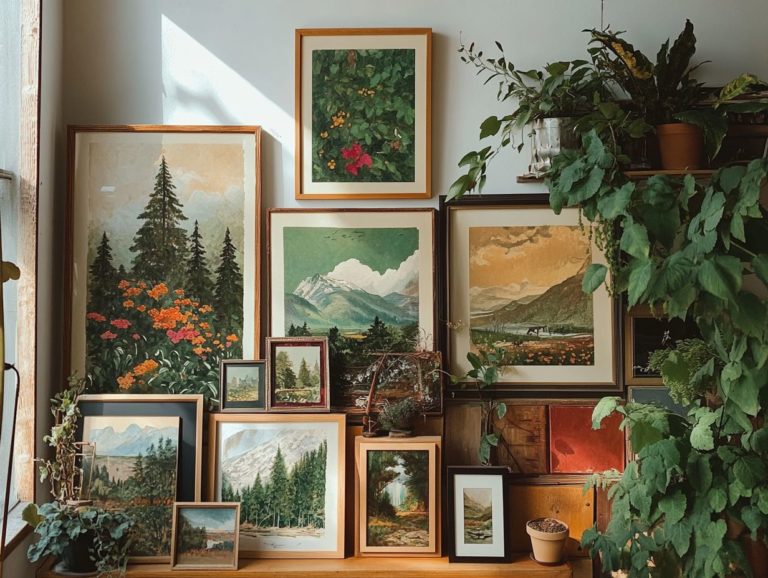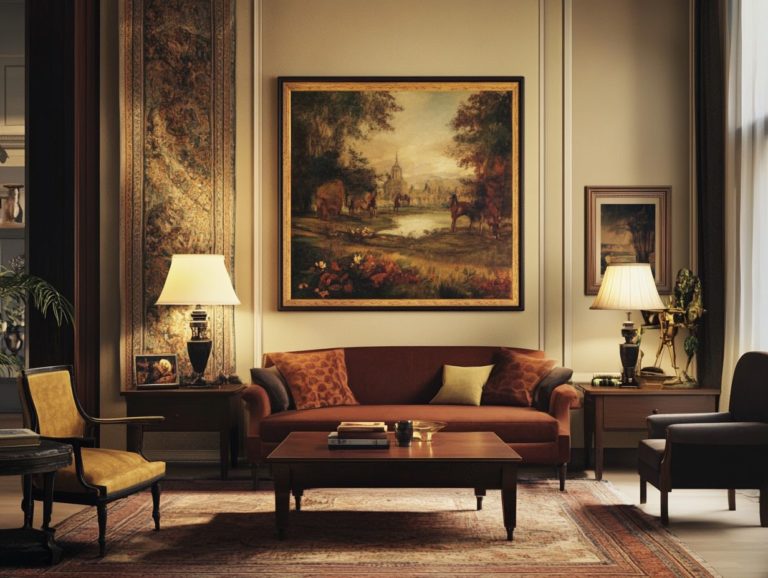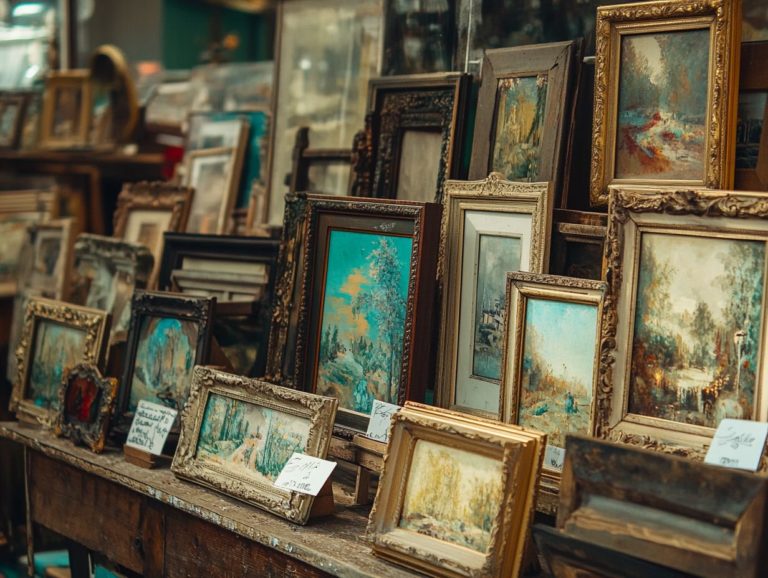How to Identify Authentic Vintage Wall Art
Vintage wall art possesses a unique charm that transcends time. It often narrates stories of the past through its colors, styles, and craftsmanship. As its popularity continues to rise, you may face the challenge of distinguishing genuine pieces from reproductions and fakes.
This guide will unlock the secrets of vintage wall art! It explores the defining characteristics and history of vintage wall art. Additionally, it delves into the factors that determine authenticity and offers practical tips for spotting valuable pieces, including original paintings and vintage art prints.
Whether you re a seasoned collector or simply curious, you ll acquire the knowledge needed to navigate the captivating world of vintage art. This includes techniques for buying art and appreciating real art.
Contents
- Key Takeaways:
- What is Vintage Wall Art?
- Factors to Consider when Identifying Authenticity
- Identifying Reproductions and Fakes
- Methods for Authenticating Vintage Wall Art
- Tips for Spotting Valuable Vintage Wall Art
- Frequently Asked Questions
- How can I tell if a piece of wall art is truly vintage?
- What materials were commonly used in vintage wall art?
- How can I identify the style and design of vintage wall art?
- Are there any specific markings or signatures to look for on vintage wall art?
- Wondering how the condition of vintage wall art affects its value?
- Where can I find reliable information about vintage wall art and its authenticity?
Key Takeaways:

- Discover the defining characteristics of genuine vintage wall art and appreciate its rich history.
- Learn how to identify reproductions and fakes by paying attention to materials, techniques, age, and condition. Seek expert appraisal and verification if needed.
- Understanding popular styles, artists, and market value can help you spot valuable vintage wall art, including limited-edition prints and vintage posters.
What is Vintage Wall Art?
Vintage wall art embodies a timeless charm. It features original paintings and vintage art prints that capture the essence of bygone artistic movements. This genre invites you to immerse yourself in a rich tapestry of art history and offers a chance to appreciate pieces that resonate with your taste in art.
Often, vintage wall art comprises works that belong to the public domain. This makes them accessible for elevating your home decor and art display. As the art market evolves, your appreciation for vintage pieces can flourish. For deeper insights, explore the symbolism of vintage wall art. More collectors like you are seeking authenticity, unique character, and budget-friendly art to enhance their collections.
Defining Characteristics and History
Vintage wall art captivates with its distinctive aesthetics. It often showcases original paintings from historical movements such as Impressionism and Art Deco. These pieces typically come framed in vintage frames, which not only protect them but also enhance their artistic worth, making them suitable for home decor.
As you admire these artworks, you’ll notice how their color schemes vibrant hues harmonizing with muted tones create a captivating contrast. They evoke a deep sense of nostalgia and history, inviting you to explore their stories. The materials used vary. From rich oil paints on canvas like those found in art galleries to delicate watercolors, each reflects the artist’s technique and influences of their era.
Notable artists like Monet and Dali shaped these movements. They influenced artistic expression, paving the way for modern techniques like digital art prints and giclée prints. Over the years, vintage wall art has mirrored the shifting tides of societal values and aesthetics. To appreciate this genre fully, it’s essential to understand key considerations for vintage wall art, establishing itself as a cherished part of art history.
Factors to Consider when Identifying Authenticity
When evaluating vintage wall art, several key factors determine its authenticity. The provenance the history of ownership of the artwork is essential for establishing genuine ownership and upholding ethical art practices. Understanding the significance of artwork curation also plays a vital role.
Materials and Techniques
The materials and techniques used in vintage wall art, such as oil, acrylic paintings, and various painting methods, are essential for discerning authenticity and value.
Consider the textured surfaces of canvas, which not only amplify color vibrancy but also add depth to the artwork. In contrast, the smoothing finish of wooden panels imparts a more refined quality. Your choice of medium plays a pivotal role in conveying the artist’s intent.
Historically, artists have gravitated toward various types of paper, each bestowing unique characteristics upon their creations. Techniques like printmaking and watercolor evoke distinct emotions, enriching the viewer’s experience.
By carefully curating these elements, you greatly boost the visual appeal of vintage pieces while gaining insights into the cultural and artistic movements of their era. This interplay of materials and methods significantly shapes the overall aesthetic experience, allowing you to appreciate the art on a deeper level.
Age and Condition
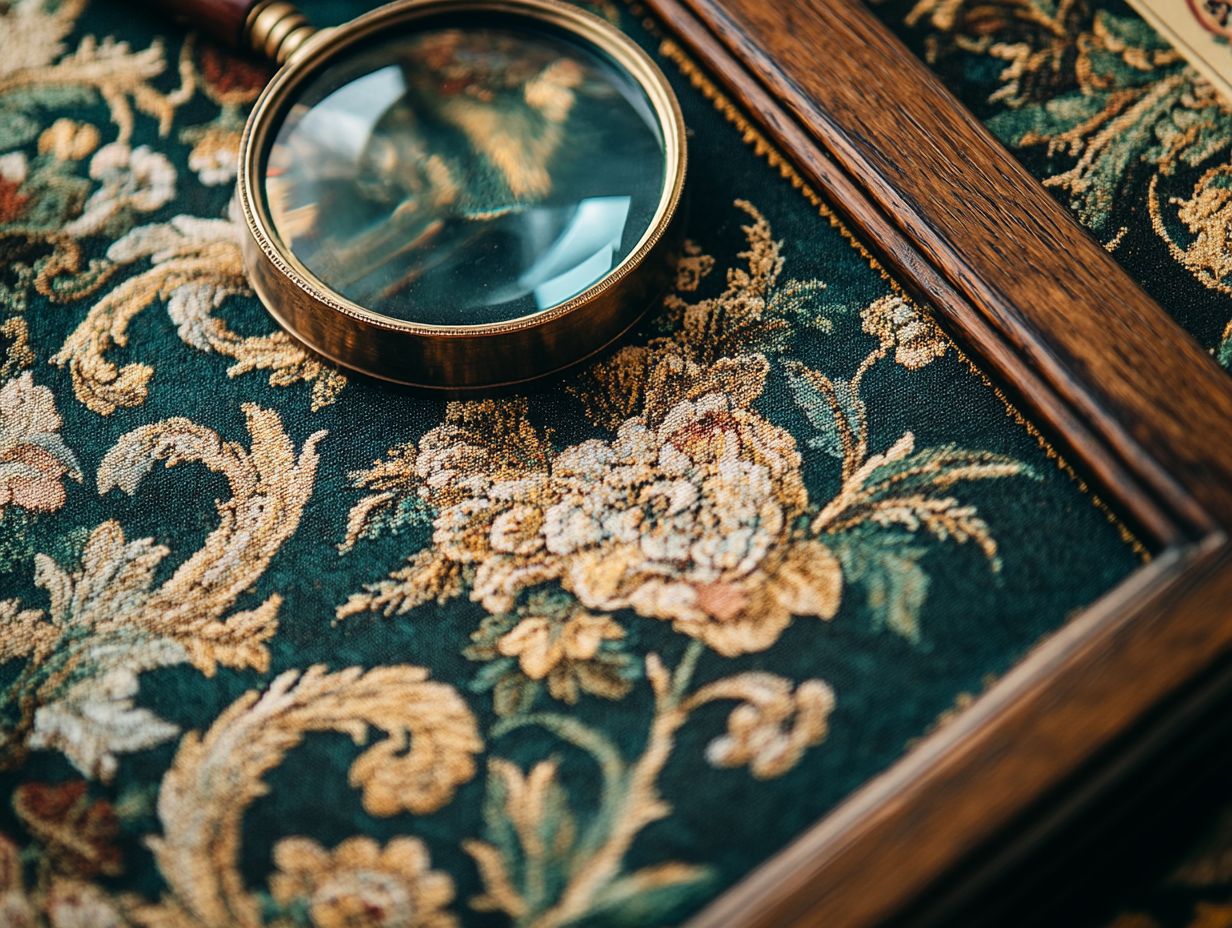
The age and condition of vintage wall art are crucial elements that directly impact pricing and market value. You ll find that well-preserved pieces often command higher prices than those showing signs of wear.
As you navigate the world of collecting, remember that the perceived value of vintage art can vary dramatically based on its age and physical condition. Generally, artworks that have retained their original qualities and features are viewed as more desirable, enhancing their appeal to potential buyers. Additionally, understanding the cultural significance of vintage wall art can also contribute to its value in the eyes of collectors.
Vintage pieces are typically regarded as acceptable once they reach at least 20 years old, although this can vary depending on specific art movements. To ensure these treasures stand the test of time, it’s essential to use methods like proper lighting, the right temperature and humidity, and protective glazing. Additionally, authenticating a piece is vital; professional evaluations can uncover the history of ownership and confirm that you’re investing in genuine art. For those looking to understand what factors affect pricing, understanding vintage wall art pricing is crucial, as it significantly influences overall value.
Identifying Reproductions and Fakes
Identifying reproductions and fakes is crucial for anyone serious about art ownership and appreciation, as well as making informed purchases in online art shops or thrift stores. These imitations can significantly dilute the value of your collection and mislead potential buyers in vintage art shops.
Being discerning in this arena not only enhances your own understanding but also preserves the integrity of the art market.
Common Signs of Inauthenticity
Common signs of inauthenticity in vintage wall art include reproduction prints, inconsistent signatures, and a lack of provenance documentation, often found in vintage art shops. Remain vigilant for irregularities in materials, such as canvas types or frames that don’t align with those typically used by the artist.
Experts often suggest examining the texture of the paint; genuine vintage pieces usually display texture variations that modern reproductions lack. Another indicator is the condition of the artwork itself: authentic vintage art may showcase signs of aging, like crackling or yellowing, which can enhance both its value and appeal. If you’re interested in finding authentic pieces, check out where to buy vintage wall art online.
It’s wise to consider the seller’s reputation, particularly in art galleries and online art shops, along with any accompanying certificates of authenticity. These elements can significantly bolster your confidence in the legitimacy of the allure of vintage wall art.
Methods for Authenticating Vintage Wall Art
In terms of authenticating vintage wall art, use expert appraisal services. These professionals assess the artwork s history of ownership, condition, and offer insights into art pricing, ensuring you have a clear understanding of its value.
Additionally, engaging in thorough research into artwork licensing can further solidify the authenticity of your piece.
Explore your vintage wall art collection further and discover the hidden gems waiting for you!
Expert Appraisal and Verification
Expert appraisal and verification are essential steps in the authentication process for vintage wall art. These services are typically offered by esteemed art galleries and professionals in the industry.
Experts utilize a blend of technical analysis, historical research, and comparative evaluation, which means comparing different pieces of art to establish authenticity. Their work may involve scrutinizing materials, techniques, and signatures to ensure that each piece aligns with its claimed origins. Additionally, understanding how to mix vintage wall art with modern decor can enhance the overall aesthetic of your space.
For collectors like you, finding a qualified appraiser means seeking someone with a solid reputation in the vintage art realm. Look for someone who understands the market’s nuances and can provide comprehensive documentation of their findings. This documentation is crucial; it safeguards your investments in real art and supports future resale opportunities, giving you confidence in your acquisitions.
Research and Comparison
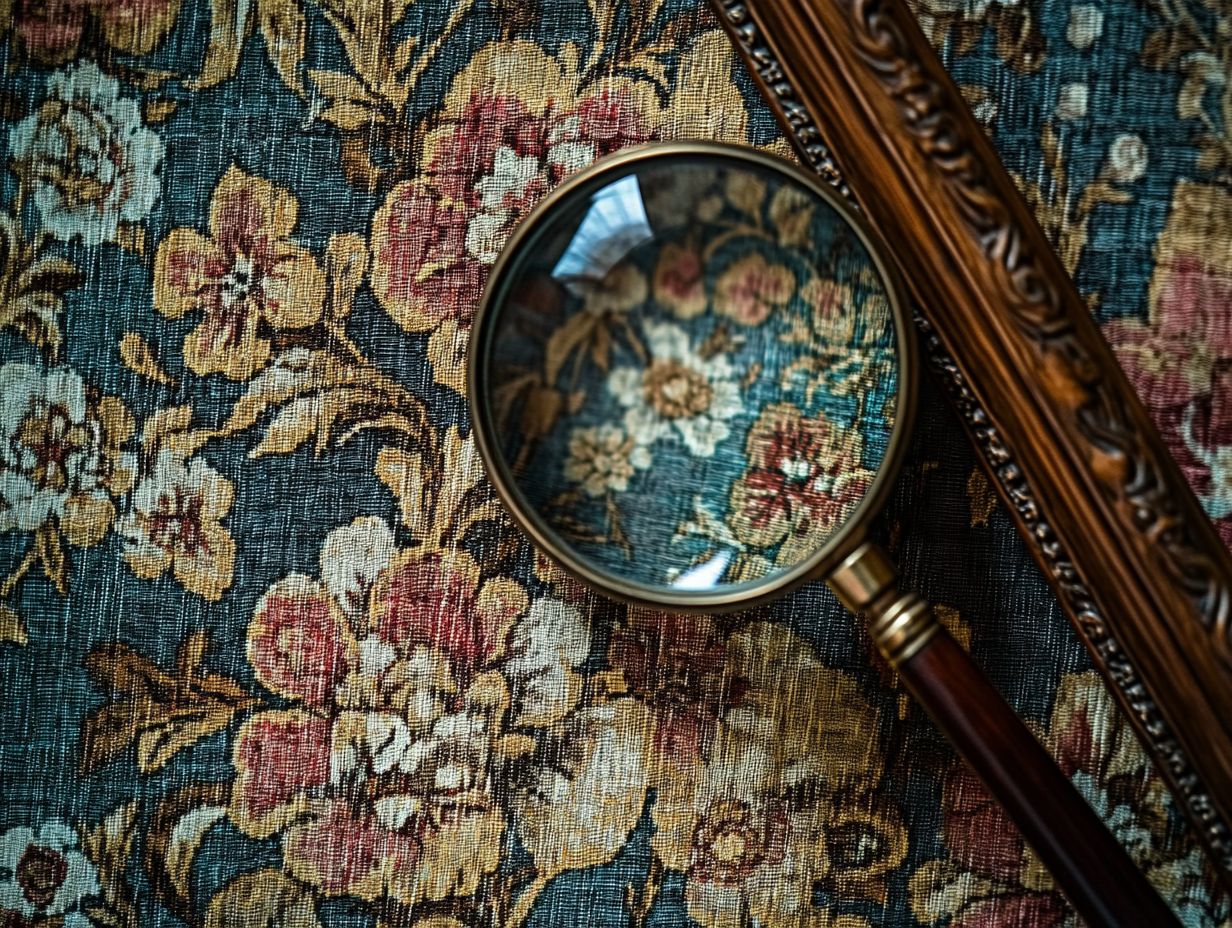
Conducting thorough research and comparison is essential for you to verify the authenticity of vintage wall art. This process allows you to trace the history and significance of each piece.
This process often begins with examining known works from established artists. Use art history references to place a piece within its era. You can explore reputable databases, art exhibitions, and auction records, which are invaluable resources for authenticating artworks and determining their provenance. Additionally, learning how to source vintage wall art can greatly enhance your collection.
Carefully comparing details like signature styles, materials, and techniques with existing records will help you distinguish originals from replicas. By implementing systematic authenticity checks, such as examining vintage frames and textures, you not only bolster your confidence in a purchase but also deepen your understanding of the evolution of vintage wall art styles and its role in cultural and historical narratives.
Tips for Spotting Valuable Vintage Wall Art
Spotting valuable vintage wall art requires a discerning eye for detail, a solid grasp of market value, and an appreciation for the diverse art techniques, such as print on canvas, that distinguish quality pieces.
It s not just about finding something that looks good; it s about recognizing the craftsmanship and history that elevate it to a truly remarkable find.
Recognizing Popular Styles and Artists
To truly appreciate vintage wall art, recognize the popular styles and artists. This knowledge provides valuable insights into the historical context and aesthetic movements that shaped their creations.
Look into the intricate qualities of styles like Art Deco with its geometric elegance and luxurious materials or the whimsical flair of Surrealism, characterized by dreamlike imagery and unexpected juxtapositions. This will help you understand how these movements emerged in response to the social and cultural trends of their times.
Consider notable artists like Gustav Klimt, known for his intricate patterns and symbolic themes, and Salvador Dal , who explored the depths of the subconscious. Their unique contributions not only captivated audiences of their era but continue to resonate today, sparking discussions about the value of emotional expression and innovative techniques in vintage art.
Understanding Market Value and Demand
Understanding the market value and demand for vintage wall art equips you to make informed decisions when buying art and investing in your collection.
By examining various factors that shape these dynamics like current economic trends, shifts in collector interest, and the rarity of specific pieces you’ll uncover valuable insights into the ever-evolving landscape of art investing. This knowledge is essential; a fluctuating economy can influence what buyers are willing to pay, while unique collectibles often attract heightened interest from enthusiasts.
Actively monitor art pricing through auction results, gallery exhibitions, and online marketplaces. This way, you can accurately track market shifts and stay well-informed in your pursuit of valuable additions to your art collection.
Frequently Asked Questions
How can I tell if a piece of wall art is truly vintage?

Look for key factors when identifying authentic vintage wall art. Consider the materials, style, design, and any markings or signatures on the piece.
What materials were commonly used in vintage wall art?
Common materials in vintage wall art include oil paintings on canvas, lithographs, posters, and woodblock prints. Each type has unique characteristics that can indicate authenticity.
How can I identify the style and design of vintage wall art?
Vintage wall art reflects the popular styles of its time. For example, Art Deco and Art Nouveau thrived in the 1920s and 1930s, while mid-century modern was popular in the 1950s and 1960s.
Are there any specific markings or signatures to look for on vintage wall art?
Many vintage pieces feature the artist’s signature or initials. These markings can provide valuable information for authentication.
Wondering how the condition of vintage wall art affects its value?
The condition significantly affects a piece’s value and authenticity. Look for signs of damage, such as tears or fading. Minor wear is expected in true vintage art.
Where can I find reliable information about vintage wall art and its authenticity?
Numerous online resources and experts specialize in vintage art authentication. You can also visit galleries, museums, and antique shops to learn more.



